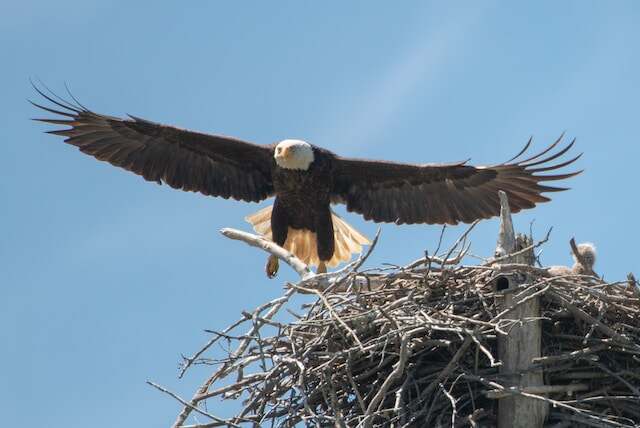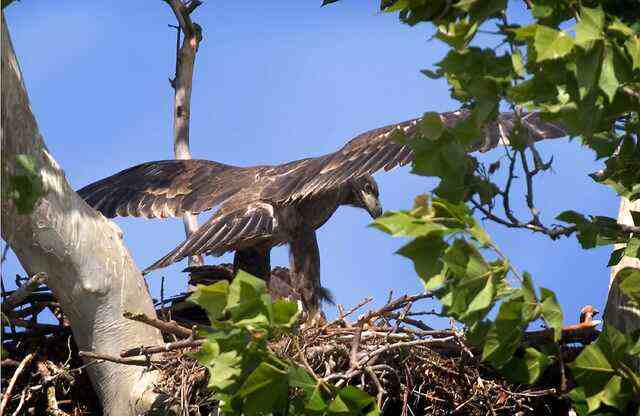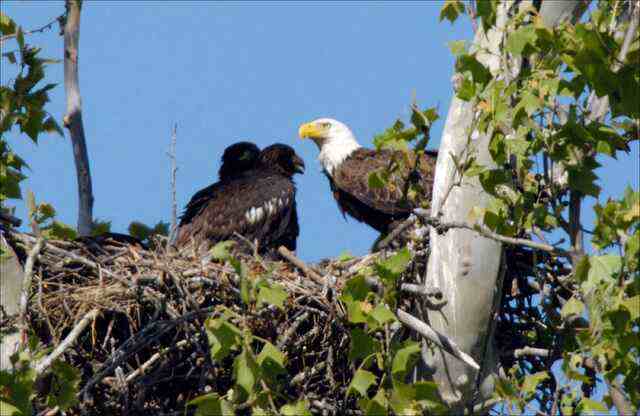Eagles are majestic birds of prey that have captured the imagination of humans for centuries. These powerful birds are known for their impressive wingspan, sharp talons, and keen eyesight.
But how do eagles fertilize their eggs? The process of reproduction in eagles is a fascinating topic that has intrigued scientists and bird enthusiasts alike.
In this article, we will explore the intricate details of eagle reproduction, from the courtship dance to the development of the egg.
We will delve into the scientific mechanisms that allow eagles to mate and fertilize their eggs, and compare their methods to those of other birds.
Additionally, we will discuss the importance of eagles in the ecosystem and the conservation efforts that are being made to protect these magnificent creatures.
Join us on this journey as we uncover the secrets of how eagles fertilize their eggs.
Table of Contents
- 1 Key Takeaways
- 2 How Do Eagles Fertilize Their Eggs
- 3 The Courtship Dance
- 4 Monogamy in Eagles
- 5 Cloacal Kissing
- 6 The Oviduct
- 7 Fertilization of the Egg
- 8 Development of an Eagle Chick
- 9 Comparison to Other Birds
- 10 Importance of Eagles in the Ecosystem
- 11 Conservation Efforts for Eagles
- 12 Frequently Asked Questions
- 12.1 How long does it take for an eagle egg to hatch?
- 12.2 Do both male and female eagles take turns incubating the eggs?
- 12.3 How do eagles protect their eggs from predators?
- 12.4 Can eagle eggs survive if they are accidentally dropped or knocked out of the nest?
- 12.5 How do eagles determine the gender of their chicks?
- 13 Conclusion
- 14 Author
Key Takeaways
- Eagles form a monogamous bond that lasts for the breeding season and mate for life with the same partner.
- Transfer of sperm in eagles involves cloacal kissing and requires precise timing and coordination to be successful.
- The oviduct is responsible for the formation of the eggshell and fertilization of the egg.
- Eagles use their keen eyesight to locate potential partners and courtship involves intricate maneuvers demonstrating strength and agility.

How Do Eagles Fertilize Their Eggs
Eagles fertilize their eggs through internal fertilization. During mating, the male eagle transfers sperm to the female’s reproductive tract.
The sperm then fertilizes the eggs as they are released from the female’s ovaries. This process ensures the continuation of the species and the development of eagle offspring.
The Courtship Dance
The courtship dance of eagles involves a series of intricate maneuvers that demonstrate the strength and agility of the birds.
Often performed while flying high in the sky, the dance includes moments where the eagles lock talons and tumble towards the ground.
This ritual not only helps to establish a bond between the pair, but it also plays a crucial role in fertilizing the eggs that the female eagle will lay.
Flying High in the Sky
Aerially soaring, eagles traverse the skies in search of a suitable mate to fertilize their eggs. These majestic birds have evolved over time with unique adaptations to survive at high altitudes, utilizing gliding techniques and specialized respiratory systems to maintain flight.
Eagles use their keen eyesight to locate potential partners, and once a suitable mate is found, the male will perform a courtship display to impress the female.
The pair then engages in a spectacular aerial dance, soaring high above the ground and performing synchronized maneuvers.
During this dance, the eagles will lock talons and tumble towards the earth, only releasing at the last moment to avoid a fatal crash.
This impressive display not only solidifies the bond between the pair, but also ensures that the fertilization of the eggs will be successful.
Locking Talons
Utilizing their specialized respiratory systems and gliding techniques, eagles engage in a synchronized aerial dance during which they lock talons and tumble towards the earth.
This mid-air acrobatics is not only a display of their impressive physical abilities but it also serves a practical purpose in fertilizing their eggs.
This alternative method of fertilization is crucial for eagles as they mate for life and need to ensure successful breeding for the survival of their species.
As the eagles tumble towards the ground, their talons eventually disengage, and they soar back up into the sky, ready for their next flight.
Tumbling Towards the Ground
During their mid-air acrobatics, eagles engage in a synchronized dance where they lock talons and tumble towards the ground. This freefalling maneuver is a crucial part of their mating ritual as it allows them to fertilize their eggs.
The aerial acrobatics of eagles are a sight to behold, and their synchronized movements are a testament to the bond they share with their partners.
As they spiral towards the earth, they are able to exchange sperm, ensuring the successful fertilization of their eggs.
This behavior is a remarkable example of nature’s ingenuity, and it highlights the unique characteristics of these magnificent birds.
The monogamous relationship between eagles is also a significant aspect of their mating behavior, as they remain faithful to their partners for life.
Such bonds are rare in the animal kingdom, and they add to the allure of these majestic creatures.
Monogamy in Eagles
Monogamy is a common trait among eagles, which may evoke a sense of loyalty and devotion in the audience towards these majestic birds.
Eagles form a monogamous bond that lasts for the entire breeding season, and they mate for life with the same partner.
This bond is strengthened by the shared parenting roles, where both male and female eagles take turns incubating the eggs and feeding the young.
The male eagle will typically hunt for food while the female stays with the nest, but they switch roles frequently.
Moreover, eagles are known for their elaborate courtship rituals, which involve aerial displays and the exchange of food.
These behaviors suggest that eagles value their partners and are committed to maintaining their relationship.
The concept of monogamy in eagles may be relatable to humans, as it reflects the desire for a long-term bond and shared responsibilities.
This sense of loyalty and devotion is further exemplified by the unique behavior known as cloacal kissing, which is the subject of the subsequent section.
Cloacal Kissing
Cloacal kissing is a term used to describe the behavior of birds when they touch their cloacas together, an act that is essential to the transfer of sperm from the male to the female.
The cloaca is a posterior opening in birds that serves as the opening for the reproductive, urinary, and digestive systems.
During copulation, birds engage in cloacal kissing, which allows for the transfer of sperm from the male to the female for fertilization of the eggs.
Transfer of Sperm
The process of sperm transfer in eagles is a crucial step in the fertilization of their eggs, ensuring the continuation of their species.
Eagles have a unique reproductive anatomy, where both males and females have a cloaca, which is a shared opening for excretion, mating, and egg-laying.
During mating, the male eagle approaches the female from behind and passes his sperm through his cloaca, which contains the semen, into the female’s cloaca.
The sperm then travels up the oviduct and fertilizes the egg, resulting in the development of a chick.
It is important to note that the transfer of sperm in eagles is a delicate process that requires precise timing and coordination to be successful.
This process is one of the many adaptations that eagles have developed to ensure the survival of their species.
Moving into the subsequent section about the ‘posterior opening,’ it is essential to understand the role this opening plays in the fertilization process.
Posterior Opening
In avian reproductive anatomy, the posterior opening plays a crucial role in the transfer of sperm during mating.
This opening, known as the cloaca, serves as a common passage for feces, urine, and reproductive fluids in birds.
During copulation, the male eagle mounts the female and inserts his cloaca into hers, allowing the transfer of sperm.
The cloacal sphincter, a muscle that surrounds the opening, contracts to keep the sperm inside the female’s cloaca.
This muscle contraction helps ensure that the sperm reaches the oviduct, where fertilization occurs.
The oviduct is the next step in the process of eagle reproduction, where the egg is formed and fertilized.

The Oviduct
Fertilization of the eagle’s eggs takes place in the upper portion of the oviduct, a muscular tube that connects the ovary to the cloaca.
The oviduct is divided into five regions, with each region serving a distinct function.
The first region of the oviduct is responsible for the formation of the eggshell, while the second and third regions secrete albumen and other fluids that will surround and protect the developing embryo.
The fourth region is where fertilization occurs, with the sperm from the male stored until it meets the ovum released from the ovary.
The fifth and final region of the oviduct is where the egg is laid.
The oviduct is a crucial component in the reproductive process of eagles, ensuring the proper development and protection of the egg until it is ready to be laid.
Moving forward, the fertilized egg will undergo a series of developmental stages before hatching into a chick.
Fertilization of the Egg
After the sperm penetrates the ovum, a series of changes occur within the egg that will eventually lead to the formation of an embryo.
In the case of eagles, sperm delivery occurs when the male eagle transfers sperm through his cloaca to the female’s cloaca during copulation.
The female’s reproductive anatomy then takes over, as the egg travels through the oviduct to be fertilized.
Once fertilization occurs, the egg begins to divide and undergo a series of changes, including the formation of a blastoderm, which is a layer of cells that will eventually give rise to the embryo.
The egg is also surrounded by protective layers, including the chalaza, which helps to keep the yolk in place, and the albumen, which provides nutrients and protection for the developing embryo.
These protective layers are crucial for ensuring the survival of the embryo and later, the chick.
The development of an eagle chick is a complex process that involves a variety of stages, from the initial fertilization of the egg to the hatching of the chick, and will be discussed in the subsequent section.
Development of an Eagle Chick
The development of an eagle chick involves a complex process of stages that are crucial for its survival and growth.
From the moment the egg is fertilized, the embryo undergoes rapid cell division, leading to the formation of the vital organs.
The chick’s diet plays a significant role in its growth stages, as it relies on its parents for food until it is able to hunt for itself.
As the chick grows, it molts its downy feathers and replaces them with feathers that are better suited for flight.
The last stage of development involves leaving the nest and learning to fly. To evoke an emotional response in the audience, consider the following table:
| Growth Stage | Emotional Response |
|---|---|
| Hatching | Joy and wonder |
| First flight | Freedom and awe |
| Independence | Pride and hope |
As the eagle chick matures, it can be compared to other birds to understand its unique characteristics and adaptations.
Comparison to Other Birds
Comparing the development of an eagle chick to other bird species can provide insight into their unique adaptations and behaviors, despite potential objections that argue against generalizing bird development.
Behavioral patterns and reproductive anatomy play a crucial role in determining how birds fertilize their eggs and raise their young.
Eagles, like many other birds, have a cloaca, which is a common opening for their reproductive, urinary, and digestive systems.
During mating, the male eagle mounts the female from behind, and they touch their cloacas together to transfer sperm.
However, not all birds fertilize their eggs in the same way.
For example, some birds, such as ducks, have a penis, while others, such as chickens, lay eggs without mating.
These differences in reproductive anatomy and behavior highlight the diversity of bird species and their unique adaptations to their environments.
Understanding these differences can provide valuable insights into the evolution and ecology of birds.
Moving forward, it is important to recognize the critical role that eagles play in the ecosystem, beyond their reproductive behavior.
Importance of Eagles in the Ecosystem
Despite the differences in how birds fertilize their eggs, eagles are crucial members of the ecosystem due to their unique role in the food chain.
Eagle populations are important indicators of the overall health of an ecosystem, as these birds of prey are apex predators that control the populations of their prey species.
They also play a significant role in nutrient cycling, as they consume carrion and transfer those nutrients to the soil.
In addition, eagles have cultural and economic importance, as they are often symbolic of freedom and are a popular attraction for ecotourism.
Conservation efforts for eagles are crucial to maintain their populations and preserve the health of their habitat.
Conservation Efforts for Eagles
Conservation efforts are essential in ensuring the survival of eagle populations and preserving their important role in maintaining the health of their ecosystem.
Protecting habitats is a crucial aspect of eagle conservation, as they require large areas of undisturbed wilderness for nesting, hunting, and raising their young.
Habitat loss and degradation due to human activities, such as deforestation, mining, and agriculture, are major threats to eagle populations worldwide.
Reducing human impact on eagle habitats can be achieved through the implementation of conservation policies and regulations, as well as by promoting sustainable land use practices.
In addition, efforts to reduce the use of toxic chemicals and pollutants, such as pesticides and lead ammunition, can help to mitigate the negative impacts of human activities on eagle populations.
By working together to protect eagle habitats and reduce human impact, we can ensure the continued survival of these majestic birds and the crucial role they play in maintaining the health and balance of their ecosystems.
Frequently Asked Questions
How long does it take for an eagle egg to hatch?
The average incubation time for an eagle egg is around 35 days, but environmental factors such as temperature and humidity can affect this. For example, in colder climates, incubation may take longer. Understanding these factors is crucial for successful breeding and conservation efforts.
Do both male and female eagles take turns incubating the eggs?
In eagle breeding, both male and female birds play distinct parental roles, including incubating eggs. While females typically spend more time incubating, males also contribute to the process, taking turns to regulate the temperature and ensure successful hatching.
How do eagles protect their eggs from predators?
To protect their eggs from predators, eagles construct nests in high locations and use their sharp talons and beaks to defend against potential threats. They also provide extensive parental care, including incubating and feeding the young until they are ready to leave the nest.
Can eagle eggs survive if they are accidentally dropped or knocked out of the nest?
Eagle egg survival depends on the nesting habits of the species. If accidentally dropped or knocked out of the nest, the eggs may not survive due to the lack of warmth and protection provided by the parents.
How do eagles determine the gender of their chicks?
Eagle chick gender determination is reliant on genetic markers in eagle reproduction. These markers are identified through DNA analysis of blood samples taken from the chicks. This scientific approach ensures an accurate determination of the gender without bias.

Conclusion
In conclusion, eagles employ a complex and fascinating process to fertilize their eggs, involving courtship dances, monogamous relationships, cloacal kissing, and the oviduct.
This process is crucial to the development of an eagle chick, which goes through several stages before hatching and growing into a majestic bird of prey.
Compared to other birds, eagles are unique in their size, strength, and hunting abilities, making them an important part of many ecosystems around the world.
However, eagles face numerous threats, including habitat loss, hunting, pollution, and climate change.
Conservation efforts are therefore essential to protect these magnificent birds and ensure their survival for generations to come.
By understanding the intricacies of how eagles fertilize their eggs and raise their young, we can better appreciate the vital role they play in our natural world.
As we work to preserve their habitats and reduce the impact of human activities on their populations, we can also celebrate the beauty and wonder of these iconic birds.




